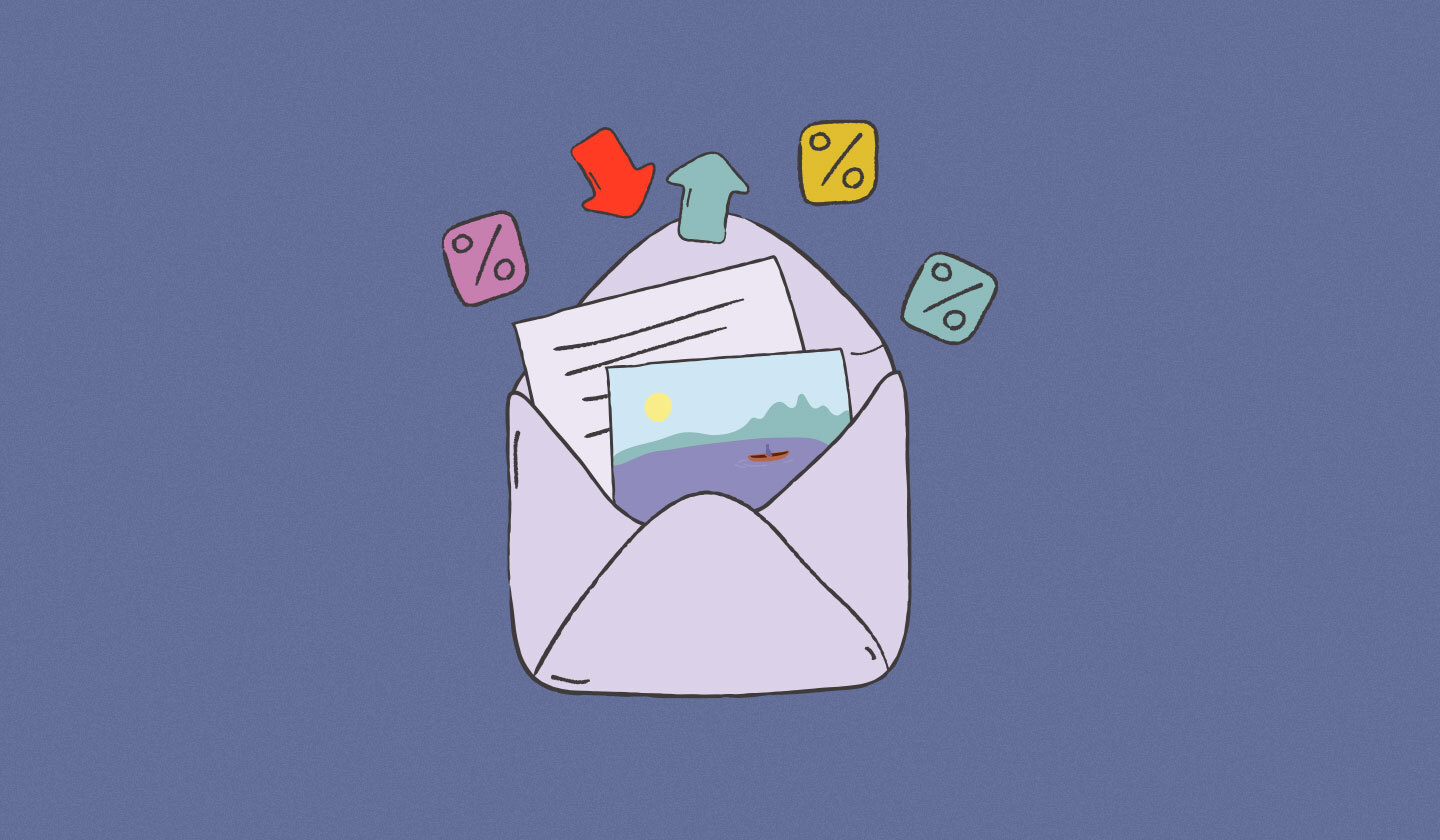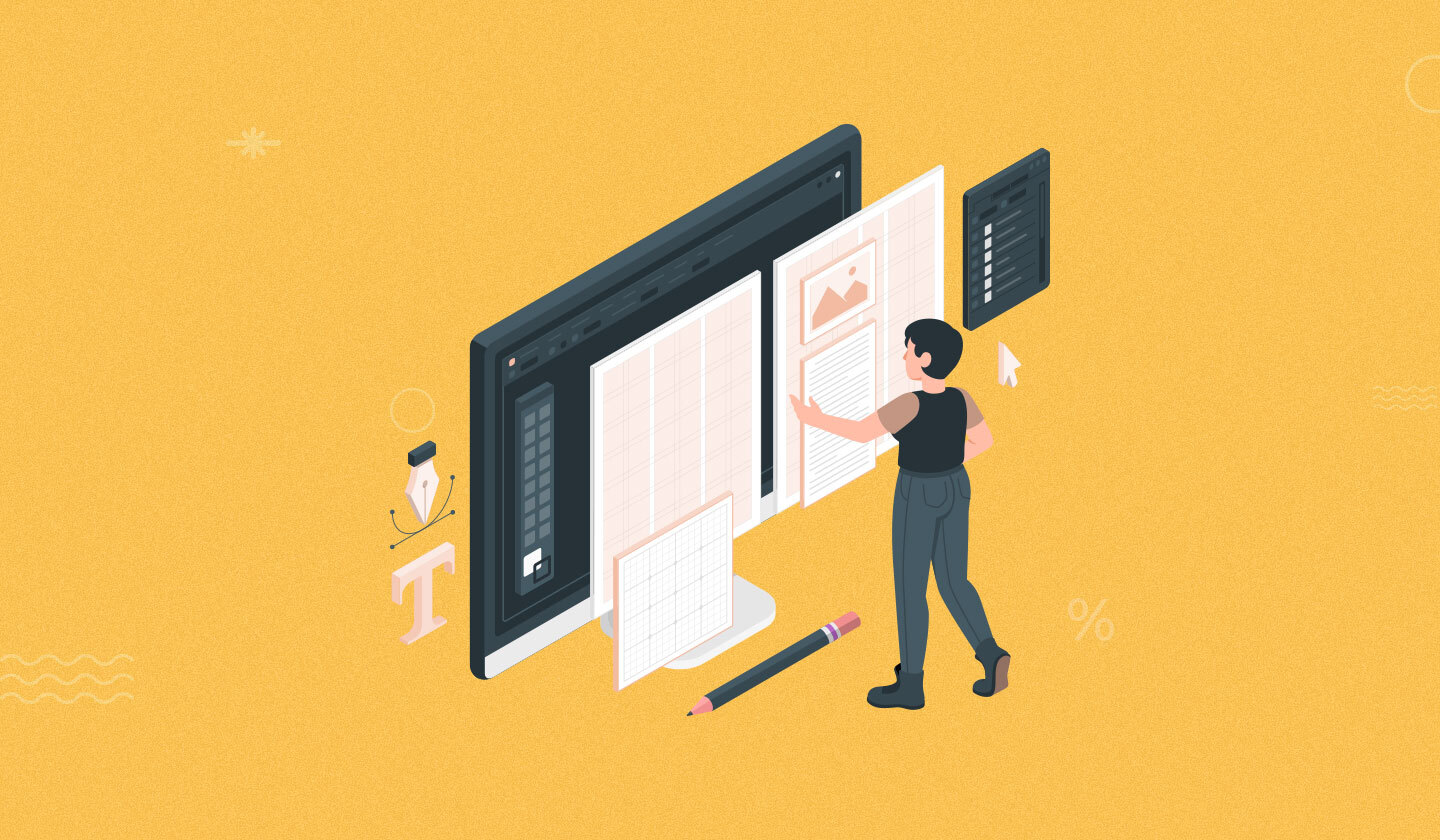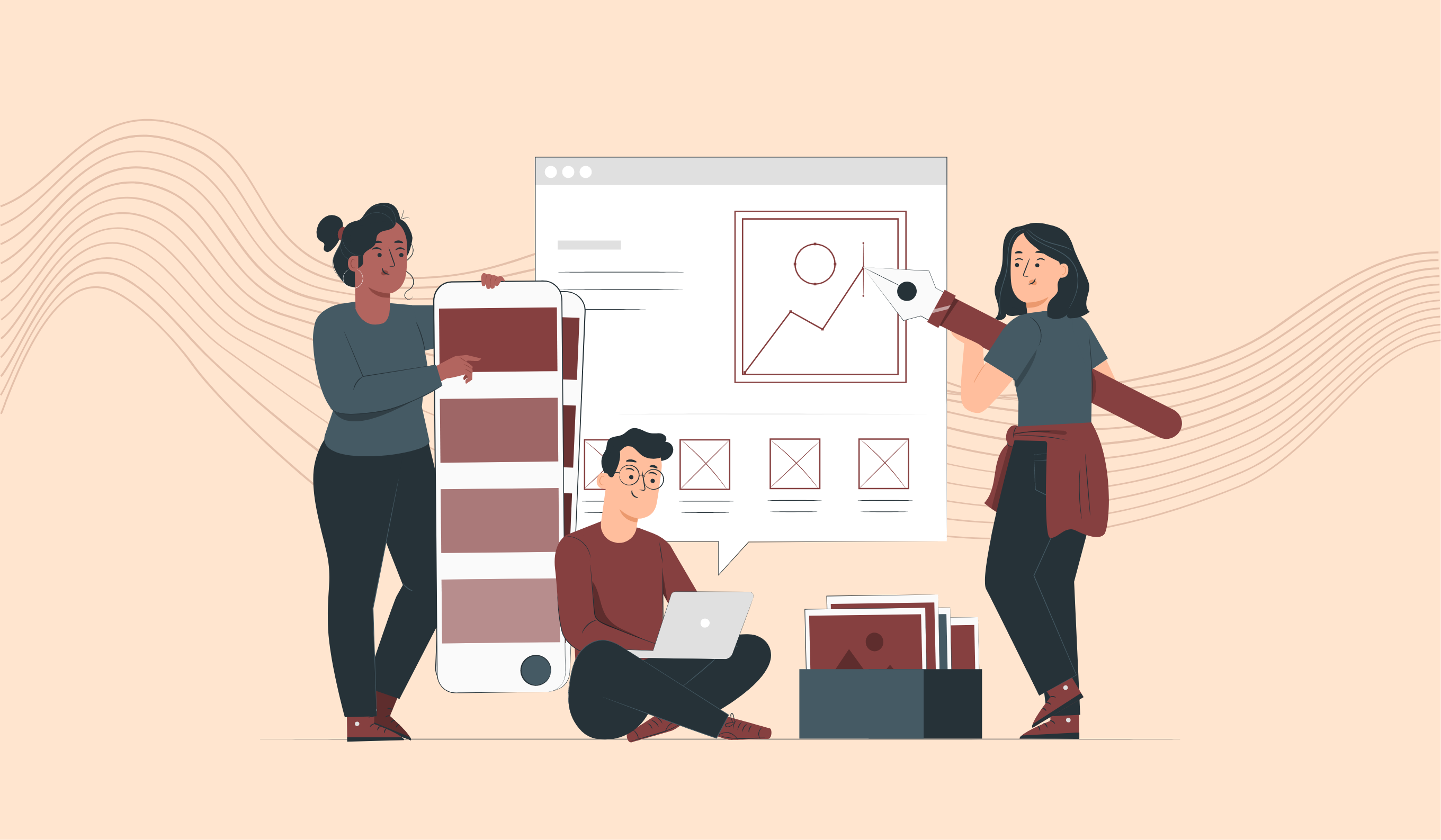Design to emails is what Robin is to Batman - inseparable.
Let’s get one thing straight; you can’t witness a successful campaign without a good email design. And no, this isn’t all talk. 20% of marketers have seen an improvement in email engagement thanks to their design.
“Okay, so I just add a picture and make my email colorful, and I’m good to go?” Umm, nope. If it was that easy, we’d never see an ugly email. But the funny thing is that it is actually quite easy; marketers just aren’t aware of the techniques to make their emails nothing short of a masterpiece.
You’re in luck since this guide explains everything you could possibly need to know about designing crazy good emails. Let’s get started.
What Is Email Design?
Email design is the strategic process of creating and designing emails to achieve a purpose, be it to boost sales during holidays or welcome new customers.
Why Is Good Email Design Important?

No matter the industry you operate in, your target audience is bombarded with emails after emails. In 2022, the daily number of emails sent is forecasted to be 333.2 billion, while the world population currently is 7.9 billion. Shall we say more?
A good email design is crucial here. It not only adds to the aesthetics but also plays a much larger role. A good email design:
Captures audience attention
Boosts conversions and revenue
Increases email engagement
Reinforces brand identity
Aids in message comprehension
Encourages social sharing and positive word of mouth
3 Broad Types of Email Design
Before we get into the nitty and gritty details about designing emails, let’s understand the 3 main types of email design that you can send to your subscribers. You can pick and choose your favorite one or select all 3 as part of your broader email marketing strategy.
1. Plain text emails
Such emails include content in its rawest form without any visuals or formatting.
They’re great for imitating a one-on-one conversation with your subscribers and display perfectly across all email providers. However, the room to play is very small with plain text emails. You can’t include call to action buttons to redirect subscribers, nor can you display pictures of your products.
2. HTML emails
HTML emails are anything but plain. They include attractive images/videos/GIFs, call to action buttons, formatted text, colored backgrounds, impressive typography, and whatnot. Anything is possible with HTML and CSS.
In the debate of HTML vs. plain text emails, the former stands out and captures viewers’ attention. Previously, only people skilled in HTML could design such emails. However, with prebuilt HTML email templates, anyone can become an email designer now. One concern, though, with such emails is that they might not render well on multiple email clients.
3. Interactive emails
These emails are relatively new in the industry. Interactive emails use Accelerated Mobile Pages (AMP) and Javascript to design highly engaging emails. Such an email design is a showstopper and is bound to get your subscribers hooked on your brand.
However, the problem with interactive emails is that most email clients don’t support them currently. So only a limited number of your subscribers can enjoy them completely.
6 Email Design Elements to Optimize

A moist chocolate cake can only be baked after you nail the different steps involved in making it. Similarly, to achieve a high converting email design, you need to perfect its different elements to the tee. We’ve not only mentioned these elements but have shared their top tips, so you become an expert in no time.
1. Graphics
If you send emails containing paragraph after paragraph of text, you’ll just end up with bored subscribers. And what do bored subscribers do? They don’t engage, and worse, unsubscribe from your mailing list. Ouch, you don’t want that. Add graphics in emails to get them excited.
An email graphic is any element that can be represented visually. Examples include static images, animated GIFs, videos, and interactive elements. You can also use an AI image generator to create visually compelling art that will leave a lasting impression on your email subscribers. Make sure you follow the below tips to create attractive email graphics:
Visuals must be added only if they serve a strategic purpose, and they must align with the message being communicated.
Choose the right format (JPEG/PNG/GIF) to keep graphics sharp while simultaneously keeping the size in check.
Instead of using stock images, go for custom-made visuals to have greater control over email design and make them on-brand.
Embed graphics by hosting them on an external source - never attach them.
2. Copy
While graphics are great for capturing attention, it is email copy that converts your prospects. Words have an impact much larger than you can ever imagine. Hence, choose them wisely. Get your notebooks and pens ready because the following tips are gold.
Don’t try to be so creative that it comes at the expense of your subscribers’ understanding. Remember, clarity matters more than creativity.
If a message can be conveyed in 50 words, don’t stretch it to 100 words.
Write in the second-person viewpoint to imitate a conversation.
Ensure the content is free from grammatical errors, jargon, and uncommon slang.
Use only those fonts in emails that display well across multiple email clients.
3. Call to action buttons

As an email marketer, Call To Action or CTA buttons should be your favorite email design element since they directly impact conversions. But including generic ‘Download’ buttons or worse, only hyperlinking text won’t do you any good.
Let’s get one thing straight; when you want your audience to take action, include a CTA button instead of hyperlinked text. The latter often appears spammy and can easily be ignored.
Secondly, use multiple CTA buttons within a single email. However, there should only be a single primary CTA button, while the other secondary ones must support it. For instance, a clothing brand would have a primary CTA that directs their reader to the main summer collection while the secondary ones would take them to the dresses, shirts, pants, and accessories pages.
Thirdly, in the copy of the email’s CTA button, mention the benefit that your recipient will receive from clicking on it. This presents another opportunity to convince your subscribers. Hence, boosting your conversion rate.
4. Colors
85% of buyers consider color as the main reason why they buy a particular item. This proves that colors in emails are an essential element that you must not compromise on.
Your choice of colors should depend on any or all 3 of the following factors:
a. Holiday-centric
Holiday emails should look festive. A Christmas email with a golden background color doesn’t really make sense. You’re better off sticking to the Christmas colors of red, green, and white.
b. Emotion-centric
What kind of emotion do you want your subscribers to feel when they look at your email? Try to elicit this by strategically choosing colors. Purple is associated with luxury, while yellow characterizes friendliness and so on and forth.
c. Brand-centric
Ideally, you’d want your subscribers to quickly identify your email in a bunch of others. This can be possible by displaying your brand colors in the emails you design.
5. Layout
The layout of an email is better described as a building’s blueprint. Without a proper structure, your email would look like it was designed by a 5th grader. Pick and choose your favorite email design layout from the following list:

a. The one-column
This is the simplest and most common email layout. It focuses on keeping both text and images justified and of similar width to ensure easy digestibility and, therefore, scrolling and engagement.
This is also a great layout when you want to keep your mobile users top of mind. Having a single column makes it easy and fast to scroll through and skim—which is all most readers do these days.
b. The inverted pyramid
For emails with a singular focus or limited information, this is often the most effective. The inverted pyramid usually starts with a full-width image followed by a centered copy block and finally a CTA button. Thus, this layout incorporates both aesthetics and function and makes for a nice, clean look.
c. The zigzag
This layout plays to a classic element of design: eye movement. By alternating the way you present text and imagery, you guide the reader’s eyes naturally from left to right, then down to the left and back to the right, which is purposely very similar to the way we read and most commonly digest information.
6. Banner
If the layout was the blueprint, then the banners are the building’s bricks. In emails, there are 3 main banners; header, body banner, and footer.
You must optimize the size of each banner for the email to display well on each screen. Each banner must also be filled with the required content and visuals. For example, it’s common practice to provide an unsubscribe link in your email’s footer and include your brand's logo in the email header design.
Email Design Best Practices for Successful Campaigns
We’ve been in the email design industry for long. Safe to say, we’ve gathered a few useful tips that’ll skyrocket the success of your email campaigns. Check them out below.
Make emails accessible for all
If your emails aren’t accessible, you’re purposely foregoing high conversions and sales. Accessibility in emails can be achieved through:
Choosing a high contrasting color palette
Adding alternative text to each email graphic
Keeping font size not lower than 14px
Avoiding animations with excessive flashing
Dividing content into different headings and smaller paragraphs
Personalize everything
Personalizing emails should be a norm for you if you want to engage and convert customers. Not surprisingly, it is the top tactic used by marketers to improve email performance. Our advice? Personalize everything.
There’s a simple way of personalizing messages by including your subscribers’ first names in the email. However, we’d recommend it if you go a little deeper. Use your audience’s data, like shopping behavior, to provide extremely personalized experiences. For instance, Netflix offers movie recommendations based on what a user has viewed in the past.
Ensure emails are brand relevant

If all your marketing communications are brand-centric, why should your emails miss out? Using your logo, brand colors, and design style in emails is a great method to boost anticipation and recall amongst your subscribers.
Ensure that your email design is relevant to your brand identity and personality. Take the email of Nike; their email design is minimalistic, innovative, and uses actionable copy.
Test, test, and test some more
Testing your emails is the only way you can know how your email will perform before you send it.
When designing HTML emails, there’s always a risk that your email might not display well across different email clients. We suggest previewing your email on multiple screens and clients either through leveraging an email marketing software or manually doing so by using email addresses of different clients, like Apple Mail, Gmail, Outlook, etc.
5 Exciting Email Design Trends for 2022
To design the best-looking emails, you need to follow the latest trends. Only then can you resonate with your subscribers and excite them to engage with your emails.
Add subtle animations
Animate your emails but subtly. Not only would this add motion to a rather static email, but it will also keep the email lighter in size and accessible for the masses. We suggest animating the element that is closer to your CTA button or one that involves an action, just like the below email from Moo.

Use HTML email templates
Designing emails can take a lot of time and money. And since you always need to come up with fresh emails to keep your customers engaged, it can become a daunting task. What’s the solution? Use HTML email templates.
A whopping 76% of brands use HTML email templates to design their emails. You should also because they’re super convenient and easy on the pocket. Different platforms, like Unlayer, offer a sizeable number of templates that you can choose based on events, industries, and usage.
Make emails bold
In 2022, we’re not going to remain shy. Why would you when you can become bold? Emails that are bold stand out in the inbox, encourage social sharing, and keep your audience anticipating your next email.
But what do we exactly mean by bold? Bold colors, bold typography, bold copy, bold subject lines - you name it. Just make sure it goes with your brand identity, and you follow other best practices. For instance, bold typography should only be added to graphics and not in content to avoid rendering issues.
The following email from Solo is exactly what we’re talking about.

Play around with data
Your audience is not going to be swept away with exaggerated claims. If you want to win them over, you need to give them the hard facts.
Use numbers in your email design and copy by highlighting your average rating, quoting a credible study, showing industry statistics, and featuring usage data of your customers.
Optimize emails for dark mode
Our last email design trend is making your emails compatible with dark mode. The latter has become immensely popular because it is easy on the eyes and saves battery life. With people moving towards dark mode, your emails should also.
Emails optimized for dark mode are not those that have a black-colored background. But rather includes an HTML code that shows the email variant based on whether someone has enabled the dark mode or not. So if someone has opted for dark mode, they will see an email designed for it and vice versa.
3 Platforms to Help You Design Better Emails
Now you know all the tips and tricks for designing good-looking emails. But to design them, you need to take the help of a few platforms/tools. We did a little research of our own and chose the best platform for each stage of the email design process.
Inspiration: Really Good Emails
Really Good Emails is a personal favorite. Consider them as the Pinterest of the email world. Over there, you’ll find hundreds of emails from industry leaders and even your competitors. You can save emails that you like and can share them with team members to pass on the inspiration.
Design: Unlayer
Okay, you’ve got the inspiration. But where do you actually design your emails? Simple, on Unlayer. With more than 1,000 predesigned HTML email templates and a user-friendly drag and drop editor, crazy good emails can be designed in a matter of minutes. The best thing about these templates is that they’re all responsive, i.e., display perfectly across multiple devices.
Testing: Litmus
Remember when we said testing is a crucial step? Litmus lets you test emails before you hit send. You can check how your email will display in 100+ email clients and get an automated QA test that lets you know if your email is optimized for high conversions.
Free HTML Email Design Templates up for Grabs
We wanted this article to be a complete package that’ll have you designing emails from the get-go. Hence, we included some of our popular templates based on different use cases. The following free templates from Unlayer are fully customizable and white-labeled. Why not check them out?
Confirmation
[

](https://unlayer.com/templates/delivery-confirmation)
Get this template
The color blocking in this template is easy on the eyes and provides a clean structure to the overall email. The multiple CTA buttons provide different opportunities to convert your audience.
Marketing
[

](https://unlayer.com/templates/giveaway-email)
Get this template
Marketing emails should be exciting. Well, so is this template. The bright yellow color stands out while the countdown timer adds an element of urgency.
Notification
[

](https://unlayer.com/templates/weather-application)
Get this template
The harmonious color palette is the focal point of this email template. The latter is perfect for notifying your prospects about different features.
Welcome
[

](https://unlayer.com/templates/customer-welcome)
Get this template
The welcome email is the perfect opportunity to start things on a good note with your subscribers. Not only is this template welcoming, but it enables you to prompt an impulsive purchase with the discount offered.
Activation
[

](https://unlayer.com/templates/registration-completion)
Get this template
This activation email template is simple yet effective. There is ample space to write a persuasive copy while the illustration provides a visual treat for the recipients.
How to Design an Email?
Designing emails with Unlayer is as easy as pie. Just follow the below steps, and you’ll have for yourself a beautiful-looking email that your subscribers will love.
Choose a template from the library of 1,000+ email templates or start from scratch.
Drag the text icon(s) to write content and change font style, size, alignment, and padding.
Drag the image icon(s) to include visuals in your email. Change the width or select auto-width for the optimal size. Write the alt-text and provide a link to redirect your audience.
Drag the button icon(s) to add a call to action button in your email.
Drag the social media icon(s) and add their links to the email’s footer.
Drag other icons, like menu and timer, as per the email need.
Once the design is ready, preview it on desktop, tablet, and mobile screens.
Export the email template to PDF or integrate with your preferred email service provider.
The following video provides a quick overview of how to easily design emails from scratch with Unlayer.
Try the most user-friendly and flexible email builder completely free of charge. Start your free trial now.
Email Design FAQs
FAQs are a life-saver. They provide quick information when you want instant answers. The following FAQs relating to email design have been answered, so you’re always on the top of your game.
What is good email design?
A good email design is one that not only looks good but achieves the targets behind your campaign. It has a balanced ratio of text to graphics, is responsive, and features click-worthy call to action buttons.
What is an email template design?
An email template design is a predesigned email layout, including textual and visual elements. These templates can be customized to make them brand and campaign specific.
How do I add graphics to my email?
Drag the image icon onto your template on Unlayer’s dashboard
Click on upload image
Select from your storage, and you’re done
How much does email design cost?
$0 to $30 using Unlayer Studio while $300 to $2,000 using an email marketing agency.
Conclusion
Designing emails doesn’t seem like a tough job after reading this thorough guide. Remember your email design should be one that appeals to your audience. On that note, happy designing!




